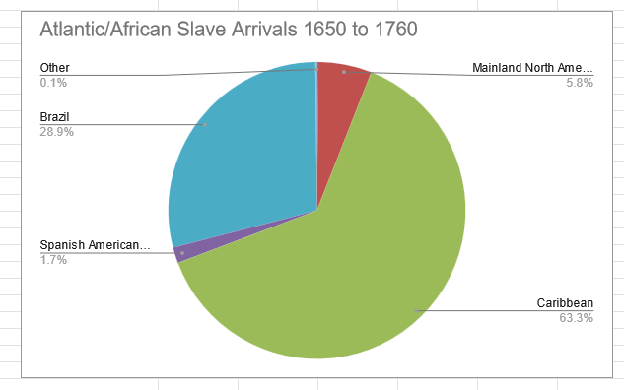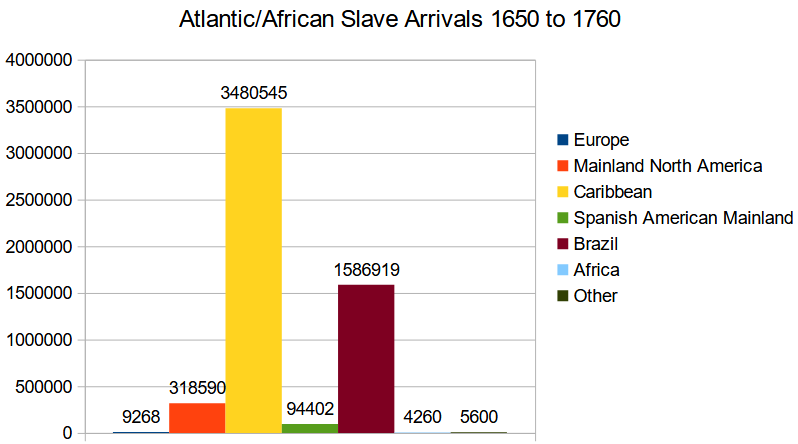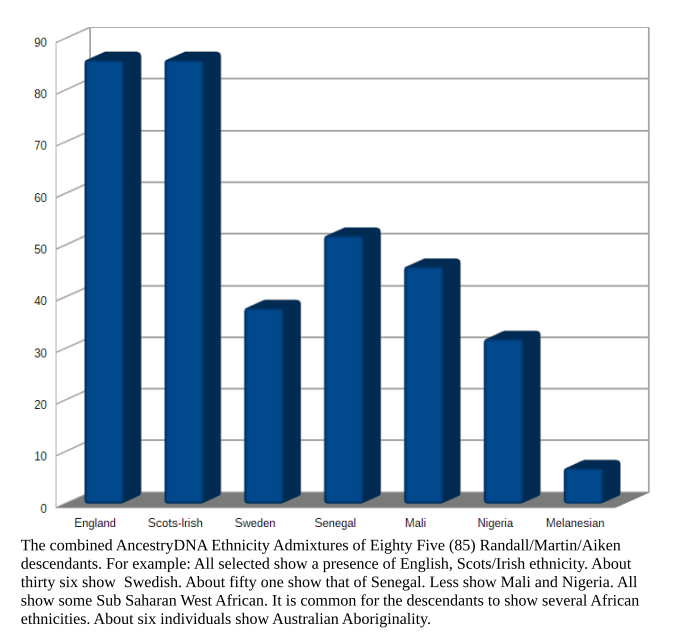Randall/Martin Family Origins: History, the DNA, and Oral Evidence

There is no doubt that the two John's were a tiny part of the grim Trans-Atlantic Slave Trade. Millions of ordinary people were stolen from their homes in Sub-Saharan West Africa, and enslaved in the new world. Some researchers estimate the number of captives sent to the New World as being between Ten to Twelve Millions over the Four Hundred of years of the trade. Although both were of African heritage, we can only definitely place John Randall in British Northern America. Of John Martin's origins we know nothing definite apart from some rather nebulous traditions with the Martin descendants that their ancestors married Jamaican "Princesses". However the proposition would be supported by the mathematics of the British Slave Trade.
Of the latter only about 4 to 6% of the total number reached what become the United States. The rest went elsewhere. This seems counter intuitive. Today there are about 45 Million Black Americans descended from the enslaved. On the other hand the Island of Jamaica has a population of only 3 Million. We are however used to looking at Western Hemisphere Slavery through the filter of the African-Americans and the United States Civil War.
This is only part of the big picture.
The Portuguese aided by the Spanish initiated the Adlantic trade, and were the last to stop. They answered for about 45-50% of the total. Most of their captives went to Brazil, Cuba, and Haiti, and were engaged in the planting, cultivation of Sugar Cane, harvesting and the manufacture of Sugar, the "White Gold" of the New World. The English/British Caribbean Islands including Jamaica and Barbados, accounted for about 50% of the total. In all the trade in slaves was a fabulously lucrative business that existed for a very long time. The European entrepreneurs bought goods from the great European cities such as Guns, Black Powder, Alcohol, Trinkets and Tools to trade in Africa for Slaves. The same ships took these unfortunate captives to the America's where they were sold to work on plantations producing Sugar, Molasses, Rum, Tobacco, Coffee, Cotton etc. which in turn was transported back across the Atlantic to European countries to be sold at enormous markups. This was known as the Triangular Atlantic Trade. The major proportion of the English Slave Trade was to Jamaica and Barbados and not directly to North America.


The North American population of chattel slaves numbered in the Millions by the mid 1800's while that of Barbados and Jamaica were only a fraction. The contradiction is easily explained by the differences in the style of barbarity. The death rate among Africans in the Caribbean Islands working in the fields was very high. The absent English Plantation Owners were quite happy to endure the costs involved with a constant labour churn. They simply didn't care that the Slaves died like flies. The latter were were cheap, and profits were astronomical. On the other hand on the mainland the legal importation was restricted because the Government in England were reluctant to fund the security that a large slave population required. The Continental Plantation owners began a serious effort in enforcing successful breeding programs. It is estimated that over time, on average, each en-slaved female produced nine children. This resulted in a near exponential growth.
Note: Different parts of the Harvard Datasets are being used. Firstly the whole 1650 to 1860, and later the 1650 to 1760. The latter are more useful in the Randall/Martin context.
The DNA evidence

The remark besides John Martin's name on the Alexander muster (entry log) when he boarded, said that he was an African "Black Man". The Y-DNA from a close Martin descendant down the male line suggests that his male line was from Cameroon, West Africa. An initial survey of the mass DNA from about 85 R/M/A descendants, including descendants of John Aiken, suggests that all three were of Sub Saharan West African descent. No birth certificates for slaves or free blacks normally. The New South Wales, (Rum) Corps entry card for John Randall from 1800, suggests that he was a "Black American" and came from "New Haven", North America. This is a coastal town in Connecticut, not too far from New York. It's trading interests looked to the sea. John Martin's life? John was born about 1755. An Y-DNA analysis of a direct male descendant, his GGGSon, was made in 2013. It revealed a common African Haplogroup of E1B1a originating in Cameroon near Nigeria. This is consistent with John himself and/or his male line being Negro Slaves at sometime.
The first written record where Martin's name appears are that of the Old Bailey Court Documents, when he is presented for trial on Wednesday 3 July 1782, in London.
Interestingly this date precedes the three significant events for Afro-Americans at the end of the Revolutionary War. These are:
(1) July 11 1782, when British forces fled the city of Savannah Georgia,
(2) the final British Evacuation of many Black Loyalists from Charleston South Carolina on December 14, 1782 , and
(3) the final evacuation of the loyalists (Black and White) from the city of New York by November 25 1783.
However since he was arrested and imprisoned in London it is possible that he was a long time resident of the city:
The Author Simon Schama, in his book "Rough Crossings: Britain, the Slaves and the American Revolution" suggests that in 1765.
"It was not unusual to see blacks on London streets. There were at least five-thousand and perhaps as many as seven thousand scattered over the metropolis, some living in fine town houses where, suitably got up in embroidered coats, powdered wigs and silk breeches, they served, ornament ally, as footmen or body servants to the quality. Some, like Dr Johnson's Francis Barber, were minor celebrities, sketched and painted as charming curiosities. The less fortunate made a living as musicians or waiters in the taverns and brothels of Covent Garden, and went home to a bare, verminous room in neighboring St Giles, where they were called "blackbirds". Far more congregated in the dockland parish of St George in the East, in the filthy streets that led from Nicholas Hawksmoor's eccentric church. Many of them were sailors, bargemen, haulers, carters and stevedores; and some for a few pence boxed bare-knuckle or played on drums and fifes to crowds in the streets and piazzas. The "blackbirds", then, were mostly poor, and were known for flitting in and out of trouble".
The John Martin, John Randall and History.
A potted history of the Revolutionary War.
The American Revolution started on April 19, 1775, with the exchange of gunfire by insurrectionist semi organised militia at Lexington, and Concord
in Massachusetts, against Redcoats of the British Army. The situation rapidly deteriorated. Contrary to popular opinion the British Army wasn't very large. The nation had had great success because
it was able to exploit it's large Naval power very skillfully and make advantageous alliances with local powers. In the medium term the British Government had to resort to employing not only Hessian troops
but those from other parts of what would later become Germany. Between 1776 and 1783 it is estimated that there were as many as 30,000 troops employed, together with their own officers, equipment,
and auxiliaries.
In November 1775, months after the Revolutionary War had begun, the British Governor of Virginia, Lord Dunmore (aka John Murray) found himself with a restive population
of insurgents and the support of only about 300 Redcoats. As a remendy to this dangerous position he issued a proclamation to the local population of slaves,
and the un-free offering release from bondage to anyone who would bear arms in support of the Loyalist cause. Whether it was intended or not this crossed a line of
arming the Black population, a prospect that many intensively feared in the light of previous slave rebellions in the New World. It also added an economic factor to the warfare,
because the Blacks performed much of the heavy work in the colonies.
The Dunmore Proclamation Virginia 1775.
By his EXCELLENCY, &c. A PROCLAMATION.
As I have ever entertained hopes that an accommodation might have taken place between Great-Britain and this colony, without being compelled, by my duty, to this most disagreeable,
but now absolutely necessary step, rendered so by a body of armed men, unlawfully assembled, firing on his Majesty's tenders, and the formation of an army, and that army now on
their march to attack his Majesty's troops, and destroy the well disposed subjects of this colony: To defeat such treasonable purposes, and that all such traitors,
and their abetters, may be brought to justice, and that the peace and good order of this colony may be again restored, which the ordinary course of the civil law is unable to
effect, I have thought fit to issue this my proclamation, hereby declaring, that until the aforesaid good purposes can be obtained, I do, in virtue of the power and authority to me given,
by his Majesty, determine to execute martial law, and cause the same to be executed throughout this colony; and to the end that peace and good order may the sooner be restored,
I do require every person capable of bearing arms to resort to his Majesty's STANDARD, or be looked upon as traitors to his Majesty's crown and government, and thereby become liable
to the penalty the law inflicts upon such offences, such as forfeiture of life, confiscation of lands, &c. &c. And I do hereby farther declare all indented servants, Negroes, or others
(appertaining to rebels) free, that are able and willing to bear arms, they joining his Majesty's troops, as soon as may be, for the more speedily reducing this Colony to a
proper sense of their duty, to his Majesty's crown and dignity. I do father order, and require all his Majesty's liege subjects to retain their quitrents, or any other taxes due,
or that may become due, in their own custody, till such time as peace may be again restored to this at present most unhappy country, or demanded of them for their former salutary purposes,
by officers properly authorized to receive the same.
Given on board the ship William, off Norfolk, the 7th of November 1775
NB: Apparently the Governor found it so threatening ashore that he took to living on HMAS William in Norfolk Harbour.
Source: https://www.gilderlehrman.org/ "Our Historical Documents"
The Proclamation was reported well beyond the borders of Virginia both by the insurgent press and the very efficient Slave grapevine.
The British Army signed up about 300 suitable ex-slaves immediately and this grew rapidly to 800.
What happened next was unexpected.
In 1775 the population of Great Britain was about eight (8) Million. That of the thirteen (13) Colonies was about two poinr four (2.4) Million, of which about half a Million were slaves.
It is estimated that between eighty (80) to one hundred thousand (100,000) of the latter eventually moved to behind British lines. A few were soldiers, but most were available to serve the
needs of the Loyalist side.
This is proportionally the greatest internal migration in the History of what later became the United States.
Another declaration was issued in 1779 by Sir Henry Clinton, the overall Command-in-Chief of the British Forces. Named the Philipsburg Proclamation. iI had a wider target audience,
not just prospective soldiers but auxiliaries to take up roles such as cooks, laundresses, nurses, and general labourers.
“To every Negro who shall desert the Rebel Standard, full security to follow within these lines, any occupation which he shall think proper.”
The British Army had been weakened by Smallpox and the usual casualties from what had turned out to be a dirty war far from home.
Blacks every where deserted their "owners" and enthusiastically endorsed the Loyalist cause.
Just like the imperialist wars in the twentieth Century the people and Parliament of the major power grew weary of the never ending cost and trouble.
On the insurgents side much support had been supplied by the Army, and Navy of the French Monarchy. At great cost to the French taxpayer.
Fighting dwindled away especially after the British loss at Yorktown and it's surrender to combined French and American forces on October 19th 1781.
The surrender of a large army led by Cornwallis and the cream of the British military sent shockwaves through public opinion in Britian.
After this action the land war gradually petered out. It did continue at sea and in other places.
Clinton was replaced by Sir Guy Carleton. He began the evacuation of both Black and White Loyalists from the American States. Discussions concerning Treaties were inituated.
Under Carleton's leadership evacuations esculated including many from Savannah on July 11, 1782, and others from Charleston on December 14.
The last British forces finally left New York on November 25, 1783 having taken up to 10,000 Loyalists with them, including thousands of ex-slaves. Washington then reentered the city in triumph.
Some of the Black Loyalists went to Nova Scotia, some went to the Caribian, others to the UK.
The Treaty of Paris was signed by U.S. and British Representatives on September 3, 1783, ending the War of the American Revolution.
Summary: Loyalist Evacuations: Savannah on 11/7/1782, Charleston on 14/12/1782. New York (final) 28/11/1783. John Martin convicted and charged in London on the 3rd July 1782
End of section
Source: Simon Schama, "Rough Crossing" Britain, the Slaves, and the American Revolution.ISBN-10 0-06-053916-X First US Edition published 2006
To be completed, a work in progress
Click here to return to main page
Copyright ©2023 Ray Fairall;